Rachel Feltman: For Scientific American’s Science Quickly, I’m Rachel Feltman. You’re listening to part two of our three-part series on the battle against bird flu.
On Monday we followed flocks of wild birds to learn how new strains of avian influenza emerge and spread. Today we’re headed out to pasture to check out the next link in the chain from shorebird to human: poultry and dairy farms.
Our host today is Meghan Bartels, a senior news reporter at Scientific American. Here’s Meghan now.
On supporting science journalism
If you’re enjoying this article, consider supporting our award-winning journalism by subscribing. By purchasing a subscription you are helping to ensure the future of impactful stories about the discoveries and ideas shaping our world today.
Meghan Bartels: It’s a clear spring day in central New York. It’s only 5:00 A.M., so it’s still nearly pitch-black out, but the birds are singing.
[CLIP: Birds chirp.]
Bartels: I’m in front of Cornell University’s Teaching Dairy Barn, and I’m here to see how milk enters our food supply—and how bird flu has infected the cows making that milk.
Carolyn Kokko: Here’s our milking parlor. It’s a double 10, so we’ve got 10 stalls on one side, 10 on the other, parallel. And we have two milking technicians. Mostly there’s one here in the pit; another one will help push up, also scrape the pens, clean things out while the cows are not in the pen and then come and help out in here.
Bartels: That’s Carolyn Kokko, director of the Teaching Dairy Barn, which is home to about 200 cows, most of whom are actively lactating.
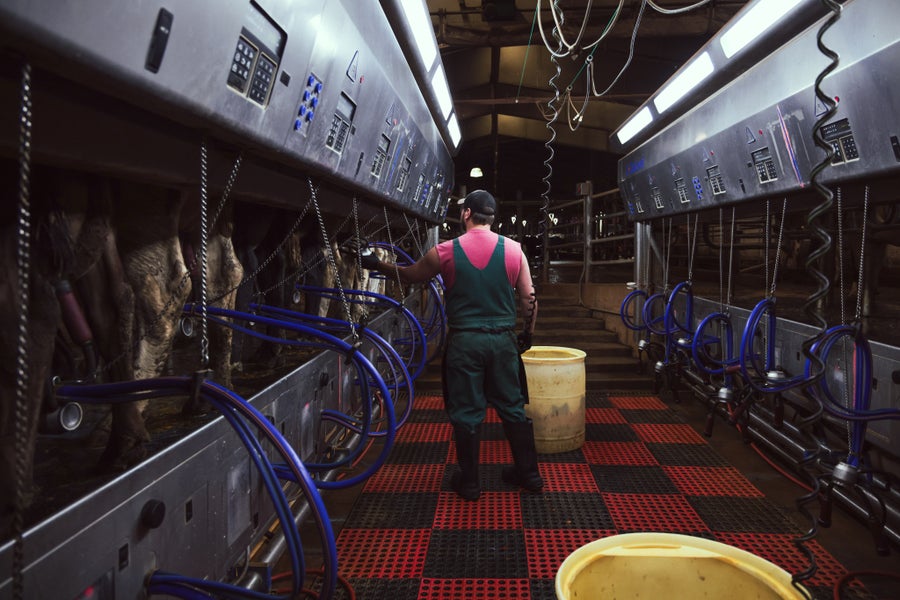
A technician checks milking apparatus in Cornell University’s Teaching Dairy Barn in Ithaca, New York.
Jeffery DelViscio/Scientific American
That means they need to be milked every day, three times a day, for about 10 months straight. Carolyn says it takes about two hours to get through the full herd during each milking.
Milkers Kevin and Mike: Hup, hup, hup!
Bartels: The cows aren’t particularly concerned with making things go any faster, so the milkers nudge the animals along as 10 of them file into each side of the milking parlor—heads facing out, tails in. Each cow wears a collar with an RFID chip that the milking machine recognizes, tallying who produces how much milk each day.
Once a group is in, the milkers prep each cow, wiping off any bedding material from their udders, sanitizing their teats and getting a little milk from them manually to make sure it looks normal. Today at Cornell everyone’s milk passes inspection. But that hasn’t been the case for more than 1,000 dairy herds in 17 states across the nation over the past year or so.
In February 2024 dairy farmers in Texas started noticing cows who were under the weather. The animals weren’t eating well, and their milk was coming out thick and discolored.
Elisha Frye: Another veterinarian who is an alumni at Cornell called me because I knew him when we were vet students, and he said, “There’s this mystery disease going through Texas, and it’s hit my farm now.”
Bartels: That’s Elisha Frye, a veterinarian at the Cornell Animal Health Diagnostic Center.
Frye: So I said, “Send me milk, and send me blood, and swab their noses, and send me some fecal samples, and we’re gonna just see what we can do.” I remember he had said there were 200,000 sick cows in the area, and I didn’t believe him because that was such a high number.
Bartels: Elisha and her colleagues received the samples and got to work. At this point, she says, scientists were antsy enough about pinning down what it was that was making the cows sick that the team decided to skip the basic diagnostics, which methodically rule out various known bugs. Instead the scientists went straight to genetically sequencing what they found in the samples.
Frye: Sequencing is when you just look for a pathogen in a sample. It’s kind of casting a very wide net.
Bartels: Within days Cornell and two other testing labs had identified the culprit: H5N1, a subtype of avian influenza, or bird flu. It was a shocking discovery, even for those accustomed to following the disease, like Wendy Puryear of Tufts University, who talked to my colleague Lauren Young in the previous episode.
Wendy Puryear: Dairy cattle have really just thrown all the rules out the window and everything that we thought we knew. Really none of us had this on our bingo card going into dairy cattle.

John Beeby of the Animal Health Diagnostic Center of Cornell University holds up samples of milk that will be tested for avian influenza, or H5N1.
Jeffery DelViscio/Scientific American
Bartels: We’ll come back to cattle, but it’s worth taking a step back to understand the bigger picture of bird flu in domesticated species. As we learned in episode one of this three-part series, avian influenza has been circulating for a long, long time.
The H5N1 strain that made the surprising leap into cows traces its roots all the way back to China in the late 1990s. From there it hitched rides around the world with migrating birds like those congregating on the shores of Delaware Bay. And it mutated all along the way.
What’s now responsible for the outbreak was first detected in wild birds in the U.S. on December 30, 2021. Within just a few weeks, on February 7, 2022, it had infected a commercial chicken farm.
That wasn’t nearly as surprising as the jump into dairy. U.S. poultry farmers have faced bird flu outbreaks before from other subtypes of the virus. For example, in an outbreak of H5N2 and H5N8 bird flus from 2014 to 2015 farmers lost more than 50 million poultry birds.
From these previous outbreaks poultry farmers knew firsthand how devastating bird flu could be when it was one of these highly pathogenic strains, which kill at least 75 percent of poultry in a commercial flock.
Mike Persia: Unfortunately, it’s a very quick process.
Bartels: That’s Mike Persia, who specializes in poultry nutrition and management at Virginia Polytechnic Institute and State University.
Persia: As those birds start to become infected that entire flock will just stop vocalizing altogether as they don’t feel well. From first detection, generally within 24 to 48 hours you’re gonna have a very high mortality level.
Bartels: That’s why after that devastating 2015 outbreak poultry farmers have worked really hard to keep bird flu out of their flocks through what’s called biosecurity measures, which include a whole host of techniques meant to stop the spread of the viruses into and between flocks.
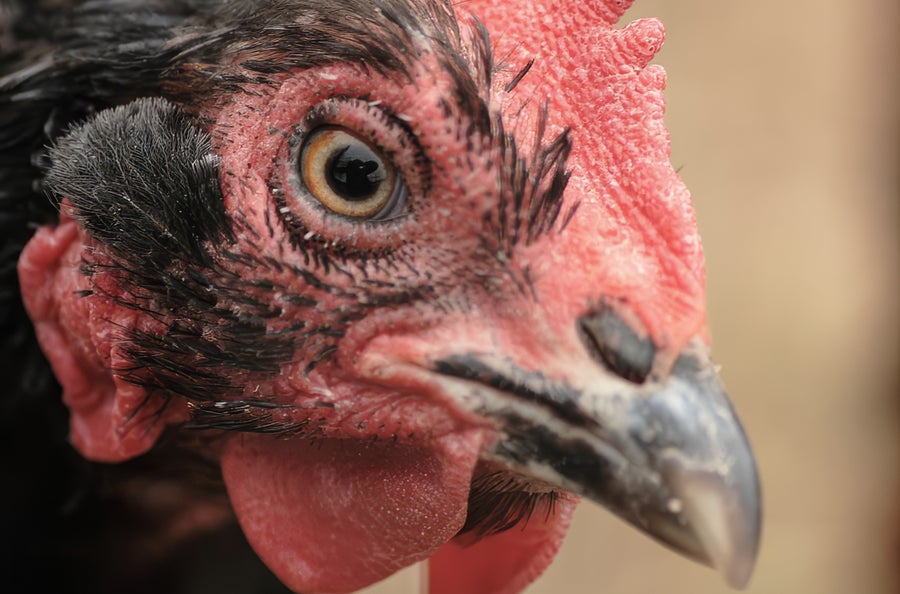
A chicken at a farm in upstate New York.
Jeffery DelViscio/Scientific American
Some farmers discourage wild birds and other potential viral carriers from getting too close to their poultry by surrounding barns with gravel. They might also plant a row of trees alongside structures to break winds that could carry viral particles to chickens. And they implement rules about what humans do, such as requiring personal protective gear and not allowing equipment to be moved from one farm to another. Mike says all these measures cost money, but they do seem to make a difference in keeping birds safe.
The most painful biosecurity measure comes when a bird flu infection does hit a flock. Because the virus can be so lethal, experts tasked with doing the awful math have concluded that it’s better for everyone to kill the whole flock right away. A mass cull reduces the virus’s opportunity to spread and mutate. Mike says that’s tough on farmers.
Persia: Yeah, I think that’s’ something that doesn’t get enough attention is the actual psychological effects. Even though these birds are raised for food there’s still a bond that develops there between the birds and the farmer. Having to depopulate an entire building of birds, I think that’s very hard on the farmers—not just from a psychological standpoint, but that’s also how they derive their living and their value.
Bartels: Since 2022, 787 commercial flocks and 919 backyard flocks in the U.S. have been infected, with a total of more than 174 million birds lost, according to government data as of early June. Those numbers are brutal, but after the 2014–2015 outbreak of H5N2 and H5N8 poultry farmers knew what to expect from the virus in terms of bird losses. What they couldn’t have predicted was that the current outbreak would last so long.
Previous outbreaks of avian influenza in the U.S. ended in the summertime because of two factors: migratory birds have gotten where they were going, so they’re not spreading the infection geographically; and the virus historically hasn’t survived well in warmer conditions.
But that changed this time around. Case rates have risen and fallen seasonally, just like human flu infections do, but the virus has lingered, never quite burning out. For more than three years now avian influenza has circulated in the U.S. among wild birds and poultry farms.
Jada Thompson: It’s different than 2015. It didn’t go away after a year.
Bartels: That’s Jada Thompson, an agricultural economist at the University of Arkansas. She says avian influenza has reshaped how the poultry industry operates—and in ways we don’t necessarily understand when we walk into the grocery store, despite all the hubbub about egg prices.
Thompson: It’s changed how we produce our birds and how we manage those farms in the U.S.
Bartels: But the impacts of bird flu haven’t been felt evenly across the sector, which Jada explains is really three or four industries in one.
Thompson: We have the turkeys, we have layers, and we have broilers.
Bartels: Turkeys are making the news a lot less, but yes, they catch bird flu, and it tends to hit them even harder. Then there are the chickens.
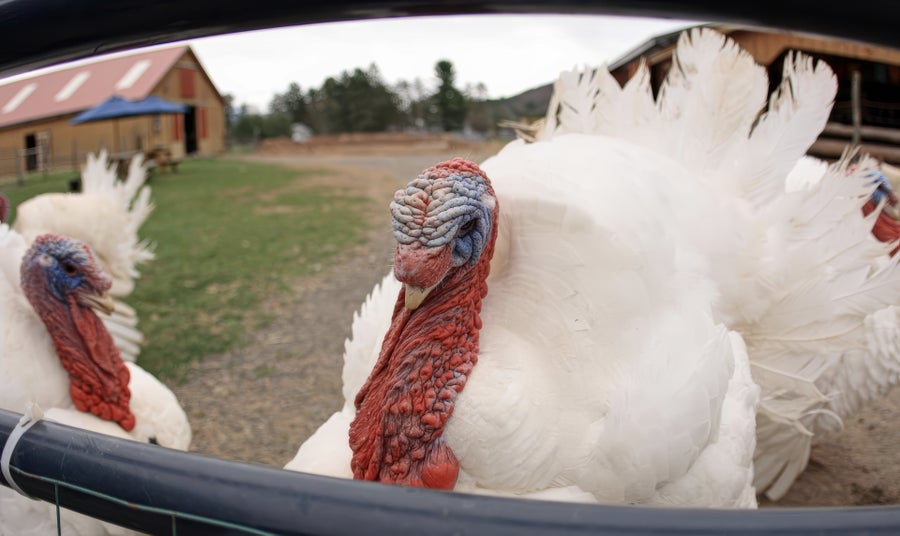
Turkeys on a farm in upstate New York. They haven’t been in the news nearly as much as chicken when it comes to avian influenza, but the virus affects them as well.
Jeffery DelViscio/Scientific American
Thompson: The layer industries are laying those eggs that we consume; those are the eggs we buy at the grocery store. And the broiler industry are those chickens that we’re gonna eat.
Bartels: In the background there’s also a breeding industry, a supply chain that moves new birds into each of these farms. Each mini industry is located in different parts of the country, exposing them to different spillover threats from wild birds.
But there are also systemic differences that shape bird flu’s impact. Among chickens broilers are only kept alive for about six to nine weeks, so farmers are used to moving them in and out of the system pretty quickly. Jada says there’s also some evidence suggesting these younger birds may be more resistant to avian influenza.
The egg layers are a different story entirely. Hens only start laying when they reach about six months old; then these birds stay in the system for a year or two, Jada says, making them much older at the end of their production time. That means losing a single layer has a bigger economic impact on a farmer than losing a single broiler.
Thompson: This isn’t just: “Birds out today, tomorrow we’ve replaced them, and then we all get on with our own way.” The system can adjust, can squeeze a little bit, but it’s really not going to fully recuperate until six months from now.
Bartels: Those differences are part of why chicken prices stayed much steadier, while egg prices rose so dramatically. Jada says egg producers were stuck in the lag between losing birds to avian influenza and cycling new birds in, right alongside the usual seasonal increase in overall demand from November to March or April, driven by the holidays.
Now that we’re past big egg season and new layers are at work, prices are coming down. The big question, of course, is what will happen next autumn. Temperatures will fall, and birds will migrate again, potentially kicking off another surge in poultry infections.
[CLIP: Cows moo.]
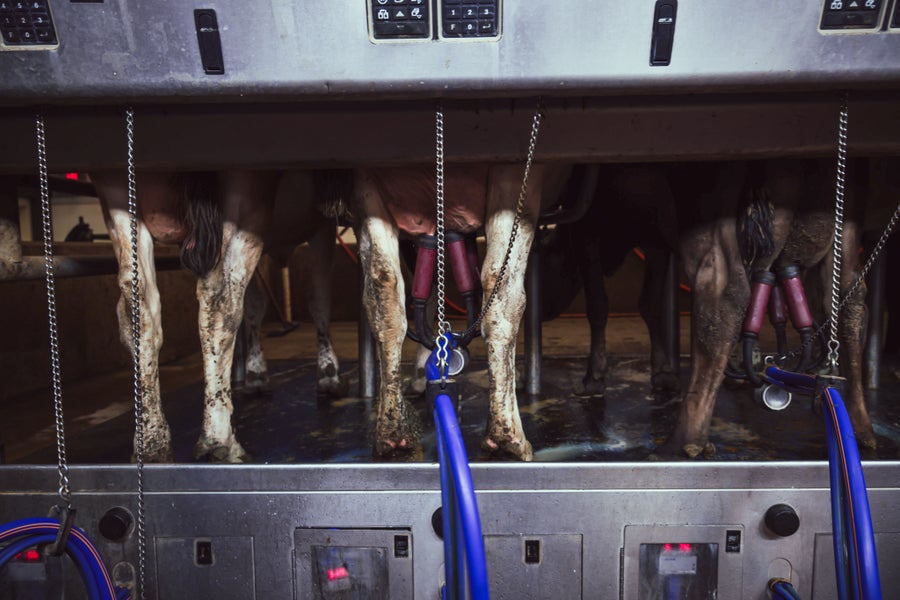
Dairy cows at Cornell University’s Teaching Dairy Barn in Ithaca, New York.
Jeffery DelViscio/Scientific American
Bartels: But we started our journey today in a milking parlor, so let’s go back to talking about cows.
Diego Diel: Everybody was surprised initially with the detection and the spillover into dairy cows.
Bartels: That’s Diego Diel, who leads the Virology Lab at Cornell’s Animal Health Diagnostic Center.
As difficult as bird flu has been for the poultry industry at least those farmers had some familiarity with the infection. For dairy farmers it was a totally unexpected experience. That makes a lot of sense given how surprising it was that avian influenza jumped into the animals that power the nation’s milk supply.
Diel: Spillovers of viruses is not something that happens on a daily basis. There are many factors that have to align and be in place for that to happen.
Bartels: And spillovers of a typically avian virus into mammals are even more unusual. As we learned in episode one of the series this particular strain of bird flu had already done that to a degree, infecting wild carnivores such as foxes and skunks within months of arriving in the U.S.
Lisa Kercher: Wild birds are dead on the landscape in much greater numbers than before with a much more virulent form of H5N1. What happens is, terrestrial mammals have started to scavenge that. So you’ve seen all that in the news, where lots of mammalian infections are happening, and so that is particularly concerning. When the avian virus jumps into a mammal it has the opportunity to mutate into—becoming more mammalianlike.
Bartels: That’s Lisa Kercher, the virus hunter from St. Jude’s with the tricked-out camper-van-turned-lab you heard from in Episode One.
But is this how the infection of that first dairy herd happened? Once the mysterious illness in Texas cows was found to be H5N1 scientists pinpointed the likely spillover source: an interaction between a sick wild bird and a dairy cow around December 2023. From there, researchers determined, most sick cows have caught the virus from other cows.
The virus has made the jump from wild birds to cows a couple more times in the year and a half since the original spillover. But in general the virus seems to spread directly within and between infected herds—more than 1,000 to date. And researchers believe that the spread was potentially accelerated by the dairy industry’s reliance on moving cows throughout the nation, a mass bovine migration that is mostly invisible to people on the outside.
Carolyn says that fortunately, unlike those early days of 2024, dairy farmers now know what to look for, like the cows stop eating as much food.
Kokko: I worked with this farm in Colorado remotely and could see from the intake data, everything just dropped one day, and it was amazing.
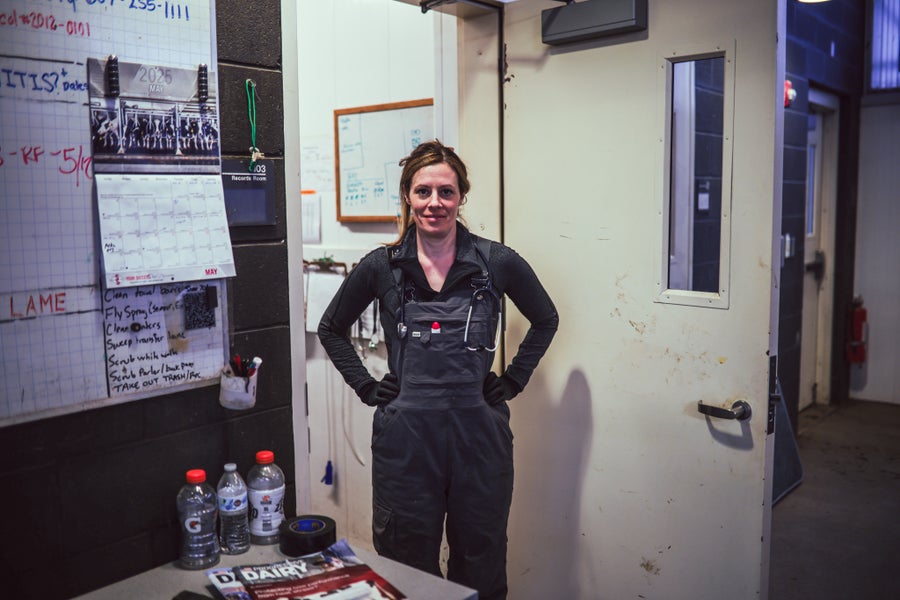
Carolyn Kokko the director of the Teaching Dairy Barn at Cornell, New York.
Jeffery DelViscio/Scientific American
Bartels: They also spend less time chewing their cud. That’s something that each cow’s collar tracks, although this bovine Fitbit of sorts measures the animals’ contented lounging instead of their daily steps.
Carolyn says that the flow of milk also slowed, with the milk machine’s daily tally for each cow falling.
Kokko: To be able to identify a virus just from something like that remotely, it was like, “They’ve got bird flu.”
Bartels: Bird flu has been most commonly detected in herds across the western half of the U.S., and H5N1 in dairy cows has come no closer to Cornell than Ohio. But the dairy cow outbreak has brought another concerning development: sick cats.
Many of the early cases were linked to dairies where farm cats who drank raw milk became very sick. Since then pet cats owned by dairy workers and even cats with no known exposures to the virus in any reservoir have also gotten sick. And unlike the cows, who typically recover from the virus, the cats are often showing neurological symptoms and even dying, which is quite rare in cows.
So it’s no surprise that Carolyn and her colleagues at the dairy barn are wary, on guard for bird flu to surprise them again.
Kokko: Things can change. Viruses change. We know that.
Bartels: But to see exactly how they can change you need viral surveillance. Just a few minutes’ drive from the dairy barn sits a hub of that monitoring network: the Animal Health Diagnostic Center, where Elisha and Diego work. The diagnostic center is one of dozens of labs across the country watching the bird flu outbreak in cows unfold by monitoring milk.
But before we go any further it’s really important to note that tests have shown heat-based pasteurization kills H5N1 in milk. So drinking milk and enjoying other dairy products is still super safe, as long as you’re not consuming raw milk.
But one of the strange aspects of avian influenza and cattle is that it seems to affect lactating cows the most. Way more virus is found in an infected cow’s milk than in other types of samples. There are even hints that milk from infected cows carried by milking equipment is potentially transmitting the virus within herds—and even to the occasional dairy worker who’s gotten a mild infection.
Still, cows need to be milked—rain or shine, sick or well. When a farmer knows their herd has bird flu they can keep sick cows separate and discard their milk. But if they have no reason to think their cows are sick, they’ll keep up business as usual—now, sometimes with one additional step: they can send vials of milk from the big tanks where the milking machines collect the goods to a lab like the one at Cornell.
[CLIP: Van driving up to dock.]
Bartels: Each day one or more vans roll up to a small warehouse space at the laboratory building. Staffers unpack a pile of boxes onto metal carts, then roll them down the hall to a big room called “receiving.”
[CLIP: Boxes moving.]
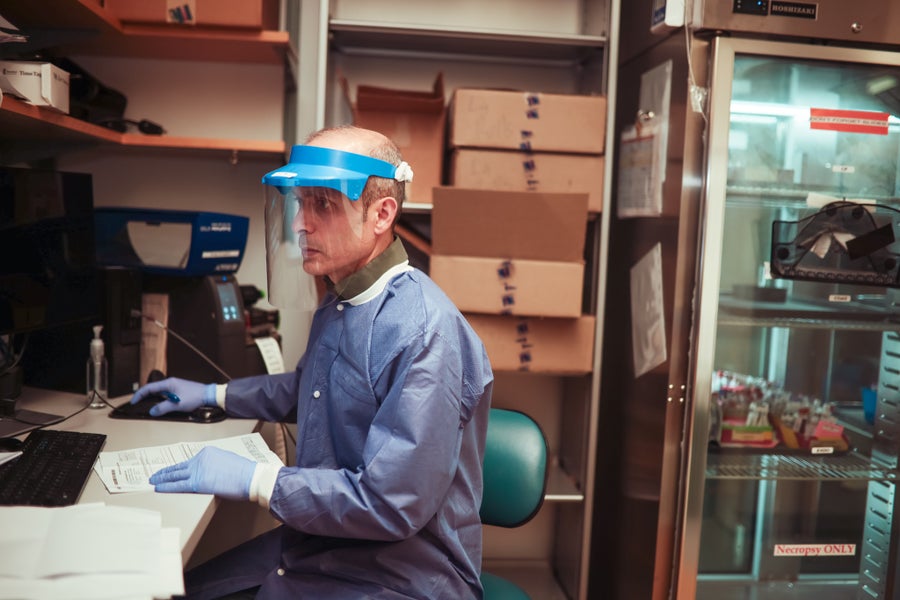
Esref Dogan, a lab processing supervisor at the Cornell Animal Health Diagnostic Center, processes milk samples to be tested for highly-pathogenic avian influenza in Cornell, New York.
Jeffery DelViscio/Scientific American
Bartels: The samples are unpacked, checked in and then sent up two floors to the Molecular [Diagnostics] Lab.
Mani Lejeune: If you get 100 samples a day or 500 samples a day, individually piping them out to a different plate is time-consuming.
Bartels: That’s Mani Lejeune, who oversees the Molecular [Diagnostics] Lab. The team is coordinating samples coming from New York as well as states like California that need more testing support than local labs can provide.
Fortunately for Mani and his colleagues, Cornell built up on-site testing capacity during the worst days of COVID, including acquiring two big machines called liquid handlers. These machines pull a little milk from each vial into one of the wells on a small plastic tray that allows the scientists to process 93 samples at a time.
The tray makes a series of stops around the lab, with a machine in each location handling one part of the preparation.
John Beeby: And that other plate would be a wash plate.
Bartels (tape): Okay.
Beeby: That allows you to start washing all of the other cellular material off of that original DNA sample in order to purify the DNA. And that’s, that’s really our whole goal here, is isolating that DNA and then purifying it: just pure DNA here—DNA and RNA, both.
Bartels: That’s John Beeby, the lab manager, who walked me through the testing procedure, which relies on a process called polymerase chain reaction, or PCR. If it sounds familiar, that’s because it’s the process used in the 24-hour tests for COVID.
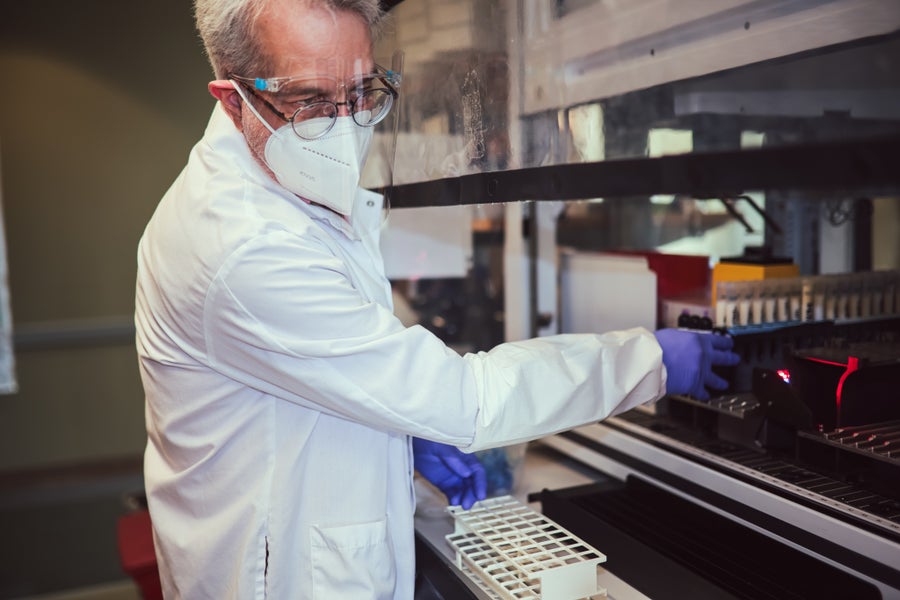
John Beeby of the Animal Health Diagnostic Center of Cornell University processes milk samples for bulk testing for H5N1.
Jeffery DelViscio/Scientific American
And it works the same way when it comes to testing for bird flu in milk. Scientists essentially add a tag that recognizes and binds to genetic material from the virus. Then the sample is heated and cooled in a particular way that selectively duplicates whatever is bound to the tag. A fluorescent dye attached to the probe lights up during the process.
Beeby: So as amplification happens you actually will have these samples giving off fluorescence that can then be detected by the optics.
Bartels: The more virus in a particular sample, the earlier in the process it will start to light up, and the brighter it will get overall. John says the whole process in the lab, from vial to verdict, takes about four and a half hours. And it will all start again tomorrow.
When the Cornell team finds bird flu in a sample it then gets sent along to another lab run by the U.S. Department of Agriculture for confirmation. There they also sequence the virus’s actual genome so scientists can see whether and how it’s evolving. That information’s value stretches far beyond dairy barns like the one where we started the day.
Here’s Diego again.
Diel: My perspective is, given what we have seen so far, this virus is likely to continue to circulate in dairy cows. The continuous circulation of the virus in mammals can lead to mutations that will make this virus more adapted to the human receptor. That could increase the risk of infection in humans, severity of disease in humans and the potential transmissibility of the virus from human to human.
Bartels: And humans are getting sick from H5N1, although not very frequently. So far the Centers for Disease Control and Prevention has reported 70 confirmed bird flu infections in humans since 2024. The majority of these cases were in farmworkers who had contact with sick cows or chickens, and most of the infections have been pretty mild. But there’s no guarantee that will remain true.
Nancy Cox, who we heard from in Episode One about her experience leading the CDC’s influenza branch in 1997 during the first H5N1 outbreak in Hong Kong, sums up our current predicament.
Nancy Cox: It’s just an unprecedented situation. It just places the U.S. at greater risk for being the source of a new pandemic strain …
Bartels: Which is why scientists are hard at work developing vaccines that could protect people from avian influenza.
Feltman: That’s all for today’s episode. Tune in on Friday for the final installment of this three-part series, where we’ll meet some of the virologists racing to get a better understanding of H5N1—and hopefully keep it from becoming the world’s next pandemic.
Science Quickly is produced by me, Rachel Feltman, along with Fonda Mwangi, Kelso Harper, Naeem Amarsy and Jeff DelViscio. This episode was reported and hosted by Meghan Bartels and edited by Alex Sugiura. Shayna Posses and Aaron Shattuck fact-check our show. Our theme music was composed by Dominic Smith. Special thanks to Becka Bowyer and Kaitlyn Serrao at Cornell University and to Kimberly Lau, Dean Visser and Jeanna Bryner at Scientific American. Subscribe to Scientific American for more up-to-date and in-depth science news.
For Scientific American, this is Rachel Feltman. See you next time.
Additional reporting by Lauren J. Young.









